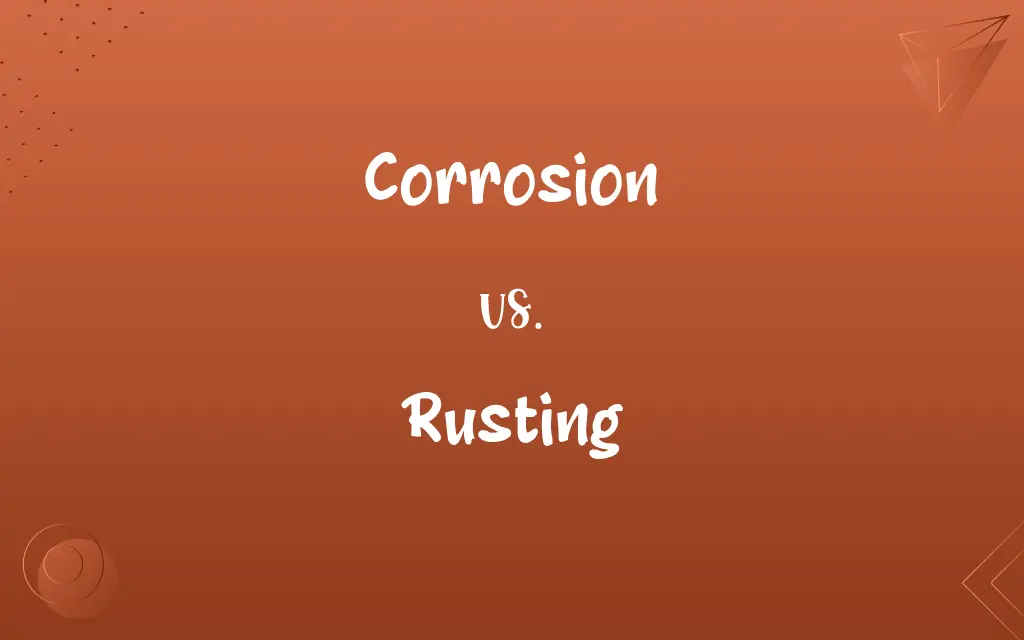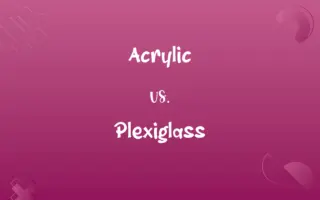Corrosion vs. Rusting: Know the Difference

By Hifza Nasir & Shumaila Saeed || Published on March 1, 2024
Corrosion is a broad term for the degradation of materials by chemical reactions, while rusting is a specific type of corrosion affecting iron and steel via oxidation.

Key Differences
Corrosion encompasses a wide range of chemical reactions where materials, especially metals, deteriorate due to environmental interactions. Rusting, on the other hand, refers specifically to the oxidation of iron and its alloys, resulting in the formation of iron oxides.
Shumaila Saeed
Mar 01, 2024
Corrosion can affect a variety of materials including metals, polymers, and ceramics, rusting is exclusive to iron-containing materials. The process of rusting requires the presence of water (or moisture) and oxygen, highlighting its specificity compared to the broader conditions that can cause corrosion.
Hifza Nasir
Mar 01, 2024
Corrosion can manifest through different mechanisms such as chemical attack, galvanic reactions, or environmental stress cracking, depending on the material and environmental conditions. Rusting is characterized by a red or orange coating on the surface of iron materials, indicating the presence of iron oxide.
Hifza Nasir
Mar 01, 2024
The prevention and control of corrosion involve a range of strategies including material selection, coatings, cathodic protection, and environmental control. For rusting, specific methods like galvanization, painting, or the use of rust inhibitors are employed to protect iron and steel surfaces.
Dua Fatima
Mar 01, 2024
Both corrosion and rusting have significant economic impacts, leading to the loss of materials, reduced efficiency of structures and systems, and the need for costly repairs and replacements. However, the study and prevention of rusting are particularly focused within the realm of ferrous metallurgy and protective coatings.
Shumaila Saeed
Mar 01, 2024
ADVERTISEMENT
Comparison Chart
Required Conditions
Varies (oxygen, acids, salts, etc.)
Water (moisture) and oxygen
Shumaila Saeed
Mar 01, 2024
Chemical Process
Broad (oxidation, reduction, chemical attack)
Specific (oxidation of iron to iron oxide)
Hifza Nasir
Mar 01, 2024
Prevention Strategies
Material selection, coatings, cathodic protection
Galvanization, painting, rust inhibitors
Hifza Nasir
Mar 01, 2024
Visual Indicators
Depends on material and type of corrosion
Red or orange coating (iron oxide)
Shumaila Saeed
Mar 01, 2024
ADVERTISEMENT
Corrosion and Rusting Definitions
ADVERTISEMENT
Rusting
The formation of reddish-brown ferric oxides on iron by low-temperature oxidation in the presence of water.
Hifza Nasir
Jan 22, 2024
Corrosion
A state of deterioration in metals caused by oxidation or chemical action.
Hifza Nasir
Jan 22, 2024
Rusting
Any of various powdery or scaly reddish-brown or reddish-yellow hydrated ferric oxides and hydroxides formed on iron and iron-containing materials by low-temperature oxidation in the presence of water.
Hifza Nasir
Jan 22, 2024
Rusting
A plant disease caused by a rust fungus, characterized by reddish or brownish spots on leaves, stems, and other parts.
Hifza Nasir
Jan 22, 2024
Repeatedly Asked Queries
Why does rusting only affect iron and steel?
Rusting is the result of iron reacting with oxygen and water, forming iron oxides, a process unique to iron-containing materials.
Hifza Nasir
Mar 01, 2024
What are some common methods to prevent rusting?
Common methods include galvanization, applying protective coatings like paint, and using rust inhibitors.
Dua Fatima
Mar 01, 2024
What is the main difference between corrosion and rusting?
Corrosion is a broad term for the chemical degradation of materials, while rusting specifically refers to the oxidation of iron and its alloys.
Hifza Nasir
Mar 01, 2024
How can galvanic corrosion be prevented?
Galvanic corrosion can be prevented by isolating dissimilar metals, using sacrificial anodes, or applying insulating coatings.
Hifza Nasir
Mar 01, 2024
Is corrosion always undesirable?
While usually undesirable, controlled corrosion processes are used beneficially in batteries and certain protective coatings.
Shumaila Saeed
Mar 01, 2024
Can non-metal materials undergo corrosion?
Yes, materials like polymers and ceramics can undergo forms of corrosion, such as environmental stress cracking or chemical degradation.
Hifza Nasir
Mar 01, 2024
What role does pH play in corrosion?
pH levels can significantly influence corrosion rates, with acidic or basic conditions often accelerating the corrosion process.
Hifza Nasir
Mar 01, 2024
How does environmental stress contribute to corrosion?
Environmental stress, such as temperature changes or mechanical stress, can exacerbate corrosion by creating cracks or exposing new surfaces to corrosive agents.
Shumaila Saeed
Mar 01, 2024
What is the economic impact of corrosion and rusting?
Corrosion and rusting cause significant economic impacts through material loss, maintenance, and replacement costs across various industries.
Dua Fatima
Mar 01, 2024
What is cathodic protection?
Cathodic protection is a technique used to control the corrosion of a metal surface by making it the cathode of an electrochemical cell.
Shumaila Saeed
Mar 01, 2024
How does temperature affect corrosion and rusting rates?
Higher temperatures generally increase corrosion and rusting rates by accelerating chemical reactions and increasing moisture presence.
Shumaila Saeed
Mar 01, 2024
How do coatings prevent corrosion and rusting?
Coatings prevent corrosion and rusting by providing a physical barrier that isolates the material from corrosive elements.
Hifza Nasir
Mar 01, 2024
Why do some metals form a patina?
A patina, often a form of corrosion product, can act as a protective layer that inhibits further corrosion, such as the green layer on copper roofs.
Shumaila Saeed
Mar 01, 2024
Can corrosion be reversed?
While the effects of corrosion can sometimes be mitigated or repaired, the process itself is typically not reversible.
Hifza Nasir
Mar 01, 2024
What are rust inhibitors?
Rust inhibitors are chemicals that slow down or prevent rust formation, often by forming a protective film on the metal surface.
Shumaila Saeed
Mar 01, 2024
Share this page
Link for your blog / website
HTML
Link to share via messenger
About Author
Written by
Hifza NasirCo-written by
Shumaila SaeedShumaila Saeed, an expert content creator with 6 years of experience, specializes in distilling complex topics into easily digestible comparisons, shining a light on the nuances that both inform and educate readers with clarity and accuracy.








































































